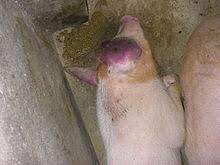 |
| Purple/blue discolouring of ear |
 |
| Weakness and high death rate of piglets |
Porcine Reproductive and Respiratory Syndrome (PRRS) is a viral disease affecting sows and other pigs leading to reproductive failure (abortions, weak and stillborn piglets, infertility), and causes pneumonia and increased mortality in young animals.
PRRS also known as blue ear disease affects only pigs. This disease is capable of causing huge economic losses to stock persons. It occurs in pigs of all ages. The PRRS destroys up to 40 percent of the pig's macrophages removing a significant part of the pig’s defence mechanism which allows secondary infections by bacteria and other viruses, particularly those that affect the respiratory system such as swine influenza, to proliferate and cause damage.
GENERAL NOTE
• PRRS occurs at different stages and age in the same farm.
• Swine fever over 40°c, anorexia, cough and pneumonia.
• Reddening of the skin, sometimes with bruises, blisters,purple/blue discoloration of the ear and tail
• Piglets suffer from splayed legs,trembling, diarrhea and high mortality rate.
CAUSE
The disease is caused by a virus and it's present in the air, saliva, nasal mucus, feces and urine.
TRANSMISSION
It's transmitted via:
• Transport of infected pigs or pork from one place to another.
• Pathogens can be transmitted via oral routes (food and water),injecting equipments, farm tools.
DIAGNOSIS
Diagnosis of PRRS virus is best performed in affected pigs during the early stages of PRRS infection. Suitable specimens are obtained from weak-born neonates that have not nursed, or clinically affected (thumping, febrile) nursing pigs, and from febrile, anorectic postweaned pigs and sows. Probably the best tissues for virus detection methods include bronchoalveolar lavage (BAL), serum, lung, lymph nodes, tonsil and spleen.
CLINICAL SIGNS
1. SOWS AND BOARS
• Abortion and still birth in sows
• Premature delivery (sows Farrow few days sooner than normal.
• Weak piglets
• High death rate of newly born piglets
• Agalactia and mastitis after birth (specific clinical signs)
• Pseudo-oestrus or slow returning to estrus after birth
• Decreased libido and semen quality in boar
2. SKIN MANIFESTATION
To differentiate clinical signs of PRRS from other skin disease of pig, PRRS infected pigs usually show;
• Skin reddening (subcutaneous congestion) or red blisters on the body
• Purple/blue discoloring of the ear, nose, legs and apex of tail. Sometimes, there are umbilicus hemorrhage in piglets.
PREVENTION
• Full vaccination as recommended by the veterinary authorities
• Provide good and nutritious diet that is not moldy.
• Keep pen warm during rain and fresh during hot period
• During weather fluctuations, use Tylodox-plus, Amprolium and Vitamins C in their feed to control bacteria.
• Carefully disinfect inside-out
• Quarantine new pigs at least for 3weeks
• Adhere to strict biosecurity at all times
• Do not buy pork with hemorrhagic manifestation on the skin.
• Do not eat undercooked meat or pig's blood soup during outbreak.
TREATMENT
There is no single successful strategy for the treatment of PRRS, largely because of virus variation, large swine populations, and unresolved issues of transmission. In some smaller herds, immunity may be sufficient so that infection is not causing significant economic losses, in which case no intervention is necessary.
Read also;
Worst piglets disease
Advantages of Camborough over other pig breeds
Best 5 pig breeds for commercial purpose
Use of tetracycline in poultry production
Arbitrary Appeal
Because this site doesn't run Google ads, you can support/encourage us financially if you're pleased and you find the post helpful.
We accept cash transfers only.
Thank you as you support us to produce a better article
Account name: ZULINKX AGRO & VET SERVICESAccount number: 2033776912
Bank: First bank plc
Follow us by clicking on the 3 parallel lines at the top right corner on this page



Comments
Post a Comment